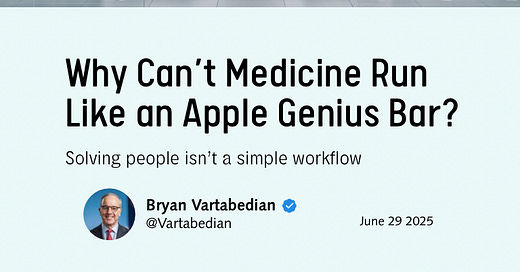Why Can't Medicine Run Like an Apple Genius Bar?
Solving people requires solution shops and value-added process encounters
This is a question I’ve heard more than once. We imagine a sleek, service-oriented experience where a problem is identified and fixed on the spot. But that fantasy says more about what we want from healthcare than what we need.
Let me explain by taking you into my clinic.
Here are two problems that I may face in a typical week:
A child with diarrhea and weight loss — cause unknown.
A toddler who swallows a button battery — cause known.
The first child needs a solution shop. That’s what Clayton Christensen (in The Innovators Prescription) called a business designed to solve unstructured problems. Like a consulting firm or research lab, it relies on expert intuition, analysis, and often multiple visits. It’s not quick. It’s not transactional. It’s messy and human.
The second child? A 10-minute endoscopic retrieval and we’re done. That’s a value-adding process encounter. It’s clear, linear, and algorithmic. Once diagnosed, the solution is obvious.
Most of medicine lives in the first category. Complex systems. Subtle signals. No two humans exactly alike.
But we keep trying to retrofit healthcare into a Genius Bar, swipe right fantasy.
The Genius Bar works because it exists in a tightly controlled environment. A limited range of devices. A narrow set of problems. A finite system that’s built to be fixed by flowcharts.
But my patient with diarrhea and weight loss is not a MacBook Pro.
Here's where it gets interesting: Clinics like Mayo have found a way to compress complex problem-solving into a defined experience — a 72-hour diagnostic sprint — but even that’s still a solution shop at its core. Just one that’s operationalized at scale. Locally, as my clinic nurses reading this know, I've been able to turn hematochezia in a 6-week-old into a VAP style encounter.
Jay Parkinson of Automate Clinic has called these situations “projects,” not visits. They unfold over time, across modalities, with trust and iteration. That’s not something you can swipe into or wrap up in 20 minutes.
Still, there are Genius Bar moments in healthcare — transactional episodes like a UTI, strep throat, or minor injuries. These are increasingly handled by telehealth, urgent care, or even phone calls. They’re boring. And they work for those focused problems.
And sure, the Genius Bar may look and feel cool. But as my fav designer Amber Case once said:
We need to stop looking at what looks cool and focus on what works. And what works often looks boring.
It’s important to remember that we’re viewing this all from the paradox of the present — the idea that we can’t see past the limits of today’s tools.
Futurist Amy Webb suggests that the tools we don’t yet have may change how we solve problems. A decade from now, real-time point-of-care diagnostics could shift the balance toward a true Genius Bar model for medicine.
We'll see.




"A decade from now, real-time point-of-care diagnostics"
Sure it could shift it to the degree most care is about accurate diagnosis which it is not
Brian, I completely agree with the differentiation between the problems plaguing a Mac vs a human. I got blue in the face trying to explain this to non-clinical executives during my managed-care days who wanted 100% of interventions to have a 4:1 ROI.
On a separate note, on behalf of nurses and others who work in your clinic and the broader healthcare system, may I suggest that you edit the reference to “my nurses.” A simple change to “the nurses” acknowledges their at-will employment and respects their autonomy. I’m sure this was an oversight, but I believe it’s important to point out.